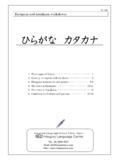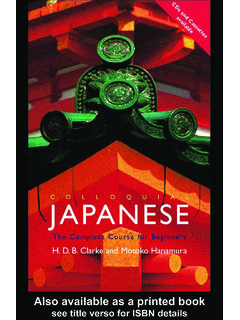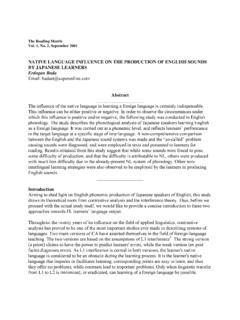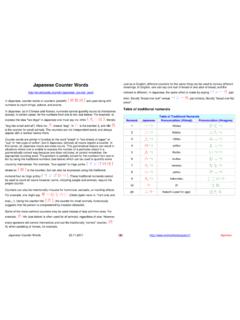Transcription of Absolute Beginner’s Guide to Hiragana (With an ...
1 1 Absolute beginner s Guide to Hiragana (With an Introduction to Grammar and Kanji) 2 3 Absolute beginner s Guide to Hiragana (With an Introduction to Grammar and Kanji) 4 Absolute beginner s Guide to Hiragana (With an Introduction to Grammar and Kanji) First Edition All rights reserved Copyright 2007 by David Petersen (All photographs Copyright 2007 by David Petersen and Mandy Conti) No part of this book may be reproduced or transmitted in any form or by any means, electronic or mechanical, including photocopying, recording, or by any information storage and retrieval system, without the written permission of the author, except where permitted by law. Manufactured in the ISBN 97851584753586452 Feedback to To Mandy, editor extraordinaire, almost outdone by Hideto Whenever you are asked if you can do a job, tell 'em, 'Certainly I can!
2 ' Then get busy and find out how to do it. Theodore Roosevelt (1858 5 1919) Temple interior, Kawagoe6 Table of Contents The Hiragana Row I: Lessons 155 (a i u e o)..17 Grammar Corner: Describing Things (It s/It s )..25 Grammar Corner: Basic Features of a Japanese First Kanji: Introduction Part (I) ..28 Row 2: Lessons 6510 (ka ki ku ke ko)..29 Grammar Corner: Describing Things (Question Form)..34 Grammar Corner: Describing Things (A is B) ..36 First Kanji: Introduction Part (II) ..41 Row 3: Lessons 11515 (sa shi su se so)..43 Grammar Corner: Here, There, and Over There ..48 Grammar Corner: This, That, and That Over There ..50 First Kanji: Introduction Part (III) ..55 Row 4: Lessons 16520 (ta chi tsu te to).
3 57 Grammar Corner: More Question Forms (Where )..63 Grammar Corner: More Question Forms (What s that?) ..65 First Kanji: (ichi) ..68 Row 5: Lessons 21525 (na ni nu ne no)..71 Grammar Corner: Use of Grammar Corner: Adjectives ( Form) ..79 First Kanji: (shichi)..82 Midway Long Vowel Recap ..88 Row 6: Lessons 26530 (ha hi fu he ho)..89 Grammar Corner: Adjectives ( Form) ..95 Grammar Corner: Yes and First Kanji: (ch )..102 Row 7: Lessons 3153 (ma mi mu me mo)..105 Grammar Corner: Nouns as Adjectives ..107 Grammar Corner: Practice with First Kanji: (ky ).. 116 Row 8: Lessons 36538 (ya yu yo).. 119 Grammar Corner: Some Everyday 7 Grammar Corner: Verbs, Objects, and The Particle.
4 125 First Kanji: (ni)..126 Row 9: Lessons 39543 (ra ri ru re ro)..129 Grammar Corner: Verbs, Objects, and Grammar Corner: Destinations (The Particle ).. 135 First Kanji: (jin)..140 Row 10: Lessons 44545 (wa wo)..143 Grammar Corner: Useful 145 Row 11: Lesson 46 (n)..149 Final Appendix A: Hiragana Appendix B: Vocabulary May your Japanese improve beyond this level of The Hiragana Chart 9 Introduction Thinking back to my first few years in the country, I remember vividly an interview I had with the dean of a foreign language institute in Osaka.
5 The man was originally from Scotland, but had been in Japan for the better part of a decade. He was married to a Japanese woman, and spoke Japanese quite fluently. Yet despite his extended stay, he remained illiterate and still required even the simplest day5to5day documents to be translated for him by his staff. How sad, I thought, and how inconvenient. I could just imagine the difficulties of trying to navigate the train system, particularly outside the big cities, or of filling out the forms required to open a bank account, sign up for a mobile phone service, or rent an apartment. In a way, his predicament was perfectly understandable. Of the tens of thousands of visitors to Japan, how many actually make the effort to tackle the written language?
6 To be fair, the challenge can seem daunting: the Hiragana syllabary, which represents the bottom rung of the ladder, consists of at least 46 basic symbols and score of derivatives. The same is true of katakana , and when we come to kanji, the ideograms that make up the core of the language, we re faced with memorizing about 2,000 characters and at least as many compounds if we want to reach even high5school level literacy. Yet many do manage to attain this level of mastery, or even beyond. Each year, the national Japanese Language Proficiency Test, the benchmark for language learning, is held at centers throughout the country. Hundreds come to try for a certificate, sitting tests held completely in Japanese, even at the lowest levels.
7 Some do it for the prestige and job opportunities, but I suspect that most just want the satisfaction of knowing that they have progressed beyond the fumbling, Japanese5 English bar conversation stage, and are on their way to real independence and cultural immersion. I did it. After six years or so of piecemeal study while teaching English I decided to buckle down get ready for the examinations. Taking one a year, I finished with the highest certificate after four years. Along the way, I turned my hobby into a vocation by finding a translation agency willing to hire me, despite my intermediate ability. Years later, I still earn a living as a translator, though now from outside Japan. My customer base is worldwide, and I m rarely without work, which arrives on a regular basis by email (have laptop will travel!)
8 As another example, a friend came to Japan with no knowledge of the language, and after a year s immersion course was accepted at Kyoto University, one of the most prestigious in the country. Writing all his essays and exams in Japanese, he completed an undergraduate degree in psychology, and then moonlighting as a translator, went on to continue his education in graduate school not bad for an ordinary kid from the Philippines! Of course, there is no such thing as a leap into literacy like everything else worth doing, written Japanese is best tackled in manageable stages. And stage I is mastery of Hiragana . 10 Hiragana : An Overview What exactly is Hiragana ? Hiragana is a symbol system that together with katakana , kanji ideograms, and romaji (characters from the western alphabet) forms the basis for contemporary Japanese.
9 Where did it come from? Early in Japanese history, a subset of Chinese kanji was adopted as shorthand for specific sounds. Hiragana evolved as a simplification of these characters at the start of the Heian period (794 to 1185 AD). The system proved to be a godsend for women in the aristocracy, who might otherwise have remained illiterate. (An education in kanji was considered suitable only for men.) Hiragana eventually became popular with writers of both sexes, and continued to evolve until recent times. The current table of characters, known as the goj on was standardized by the Japanese government around the middle of the 20th century. What is it used for? Hiragana has a number of uses in contemporary Japanese: I) Hiragana is the first writing system taught to children, because it is simpler than kanji, and it corresponds to the sounds they already know.
10 Many kid's books are written entirely in Hiragana . II) In everyday text, Hiragana is used to write very short words that either lack kanji, or have only difficult, antiquated kanji. Examples include (kore) meaning this and (made) meaning until . (See below.) III) Hiragana is used for writing the grammar elements that hold sentences together. Examples include the particles (o) and (wa), which indicate direct objects and subjects respectively, and okurigana, suffixes added to kanji to indicate pronunciation and tense1. Points II and III can be illustrated with a simple sentence: kore wa atarashii b rupen desu This is a new ball pen.








